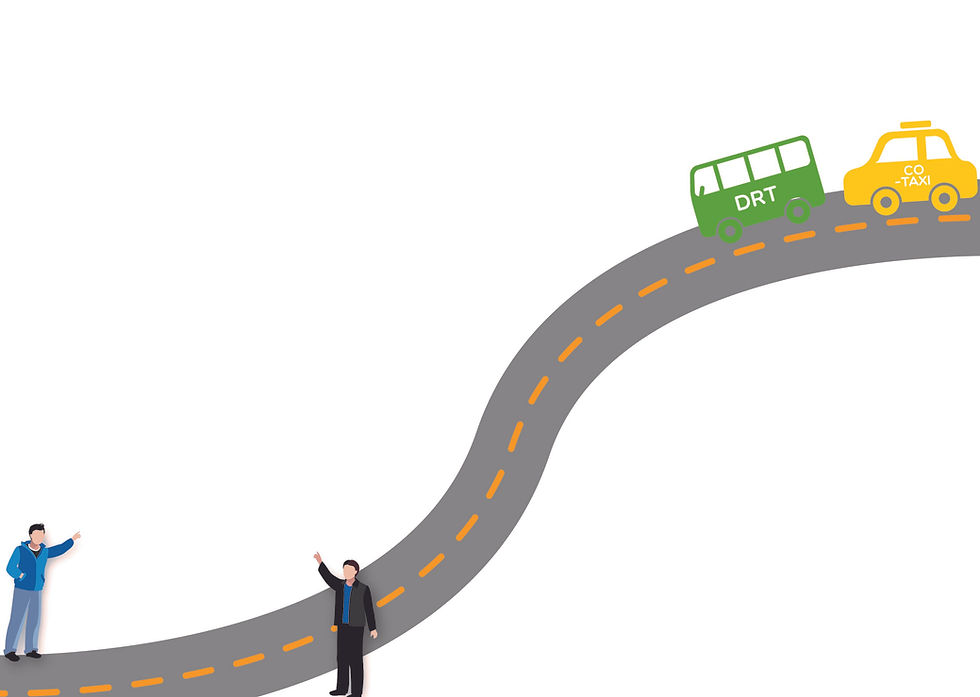[Issue] Bus And Taxi Services: Changing in Line with Users’ Needs
- Noh Hyun-jin

- 2022년 3월 11일
- 2분 분량
No. 156 / Mar 7, 2022

Users are bound to require improved bus and taxi services. However, it is not easy to meet these requirements because there are workers who depend on buses and taxis for their income. However, recently, new types of bus and taxi have emerged, reflecting the emerging needs of users without risking the livelihood of workers and using advanced information and communication technology.
The first is Demand Response Transport (DRT), a bus that responds to user demands in real time. The bus is originally a transport that the user has to match. There were many factors to consider, such as stops and dispatch times. However, in the case of DRT, when the user types their point of departure and destination in the application, the application uses Artificial Intelligence (AI) to create a real-time optimal route and stops that can be coordinated with other nearby application users. It is also called a “call bus” because it is similar to a call taxi, but unlike a taxi, costs are cheap, transferable, and approximately 11 people can ride together in real time. It is faster than regular buses and has the advantage of not having to worry about the dispatch time in traffic-vulnerable areas. Paju-si, Gyeonggi-do, and others have implemented it since December 2021.
The second is a Co-taxi, which implies a joint taxi ride. With the revision of the Taxi Development Act in July 2021, joint taxi rides became legalized by the end of January 2022. Prior to the 1986 Seoul Asian Games and 1988 Seoul Olympics, the government banned joint taxi rides in 1982. The reason was that there were many claims from users due to touting by taxi drivers, and inaccurate calculation of the fare of each passenger with a single taxi meter; it is also possible that taxi drivers and additional passengers could conspire to cause crimes. However, 40 years later, users (and not taxi drivers) can now choose a joint ride through the applications (e.g., Banbantaxi) which solves the problem by calculating fares by the route of passengers using a Global Positioning System (GPS) instead of single taxi meter. In addition, it aims to resolve the possibility of crime and anxiety by establishing regulations that allow only real names to join the application and allow same-gendered passengers to ride together. Joint taxi rides offer the advantage of being able to efficiently use taxis during late-night hour when buses are not running, or rush hour when users are crowded, for cheap fare.
With the development of information and communication technology, mobile applications and GPS using real-time data have helped better reflect users’ needs. Things that make people uncomfortable now can also be remedied in a short time with such technology.
By Noh Hyun-jin, AG Reporter
noh0605@ajou.ac.kr


![[ISSUE] Controversy Regarding Fukushima Wastewater Emission](https://static.wixstatic.com/media/c71c22_772c19f27ab442caa39ecb53a7153b13~mv2.png/v1/fill/w_854,h_601,al_c,q_90,enc_avif,quality_auto/c71c22_772c19f27ab442caa39ecb53a7153b13~mv2.png)
![[ISSUE] Korea Faces Tip Culture as Challenges](https://static.wixstatic.com/media/c71c22_6f9754c9e51a481c9dc40b7089090d1a~mv2.png/v1/fill/w_837,h_600,al_c,q_90,enc_avif,quality_auto/c71c22_6f9754c9e51a481c9dc40b7089090d1a~mv2.png)
![[Issue] Military Service Exemption Continues to Be Controversial](https://static.wixstatic.com/media/c71c22_2ad7ffce01b54246b494552cdf4180e1~mv2.jpg/v1/fill/w_980,h_734,al_c,q_85,usm_0.66_1.00_0.01,enc_avif,quality_auto/c71c22_2ad7ffce01b54246b494552cdf4180e1~mv2.jpg)
댓글